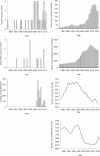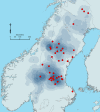Brown bear (Ursus arctos) attacks resulting in human casualties in Scandinavia 1977-2016; management implications and recommendations
- PMID: 29791471
- PMCID: PMC5965840
- DOI: 10.1371/journal.pone.0196876
Brown bear (Ursus arctos) attacks resulting in human casualties in Scandinavia 1977-2016; management implications and recommendations
Abstract
Human persecution and habitat loss have endangered large carnivore populations worldwide, but some are recovering, exacerbating old conflicts. Carnivores can injure and kill people; the most dramatic form of wildlife-human conflict. In Scandinavia, the brown bear (Ursus arctos) population increased from ~500 bears in 1977 to ~3300 in 2008, with an increase in injuries, fatalities, and public fear of bear attacks. We reviewed media coverage and interviewed victims to explore how bear population trends, hunter education, and other factors may have influenced the number of injuries and fatalities in Scandinavia from 1977 to 2016. We found 42 incidents with 42 injuries and 2 fatalities; 42 were adult men, one was an adult woman conducting forestry work, and one was a boy skiing off-piste. Thirty-three adult men were hunting bears, moose, or small game, often with a hunting dog, and 26 had shot at the bear at 8±11 m before injury. Eleven nonhunters were conducting forestry work, inspecting a hunting area, picking berries, tending livestock, hiking, harassing a denned bear, and one person was killed outside his house at night. Eight of the 11 incidents of nonhunters involved female bears with cubs; three of these family groups were in dens and two were on carcasses. The annual number of hunters injured/killed was mostly influenced by the increase in the bear population size. The pattern was similar regarding injuries/fatalities to other outdoor users, but the relation with the bear population size was weaker than for hunters, and the null model was equally supported. Bear physiology at denning may make encounters with bears more risky in the fall, when bears show prehibernation behavior. Awareness and education efforts, especially among hunters, seem important to ensure human safety. Recreationists and forestry workers should avoid dense vegetation or make noise to warn bears of their presence.
Conflict of interest statement
The authors have declared that no competing interests exist
Figures



References
-
- Sergio F, Caro T, Brown D, Clucas B, Hunter J, Ketchum J, et al. Top predators as conservation tools: Ecological rationale, assumptions, and efficacy. Annu Rev Ecol Evol Syst. 2008; 39:1–19.
-
- Estes J, Terborgh T, Brashares JS, Power ME, Berger J, Bond WJ, et al. Trophic downgrading of planet earth. Science. 2011; 333: 301–306. doi: 10.1126/science.1205106 - DOI - PubMed
-
- Ripple B, Estes J, Beschta RL, Wilmers CC, Ritchie EG, Hebblewhite M, et al. Status and ecological effects of the world’s largest carnivores. Science. 2014; 1241484, doi: 10.1126/science.1241484 - DOI - PubMed
-
- Löe J, Röskaft E. Large carnivores and human safety: a review. Ambio. 2004; 33: 283–288. - PubMed
-
- Packer C, Ikanda D, Kissui B, Kushnir H. Lion attacks on humans in Tanzania—Understanding the timing and distribution of attacks on rural communities will help to prevent them. Nature. 2005; 436: 927–928. doi: 10.1038/436927a - DOI - PubMed
Publication types
MeSH terms
LinkOut - more resources
Full Text Sources
Other Literature Sources
Medical
Molecular Biology Databases

